
Absolutely everything you need to know about visiting Machu Picchu (& new 2019 regulations)
Last Updated on 5 June 2022
Nestled high in the Peruvian Andes and shrouded in thick fog, Machu Picchu is one of the world’s most enigmatic archaeological sites, continuing to reveal new secrets even a century after its “discovery” by the American explorer Hiram Bingham. This impeccably preserved Incan citadel, which amazingly survived the country’s bloody Spanish occupation largely unscathed, is thought to have been constructed in the 1400s as a retreat for then-emperor, Pachacuti.
Although it’s still not altogether clear why the Incas abandoned the site years later, it now receives more than 1.5 million annual visitors from around the globe, all of whom come to witness for themselves the wild beauty and undeniable mysticism of Machu Picchu.
Several years after I first hiked the Inca Trail to Machu Picchu, I came back to experience the remarkable Incan ruins for a second time along the Salkantay Trek— and found that planning a visit to Machu Picchu was a lot more challenging than I remembered! This is a super-detailed, fully comprehensive guide to visiting Machu Picchu that will tell you absolutely everything you need to know before you go, including all of the options to get there, detailed information about purchasing tickets, trekking routes, what to expect inside the ruins, climbing Huayna Picchu, what to bring, new 2019 regulations, and more!
How to visit Machu Picchu
Base in Cusco, Peru
Trekking and day tours to Machu Picchu depart from Cusco, as do all of the independent transport options, so whichever way you choose to visit Machu Picchu, you’ll need to travel through the former Incan capital.
Cusco is a vibrant, culturally-rich city that deserves its own place in your itinerary— read this post for information on getting to Cusco, plus all the best things to do, how to get around, and where to stay.
Although you’ll still need to travel via Cusco to reach these spots, it is also possible to base yourself in Ollantaytambo or Aguas Calientes to visit Machu Picchu. I’ll discuss transport between all of these places in the DIY Machu Picchu section, but just know that, no matter what, you’ll begin your journey in Cusco.
Read more: THE ULTIMATE CUSCO TRAVEL GUIDE: 25 AMAZING THINGS TO DO IN CUSCO, PERU
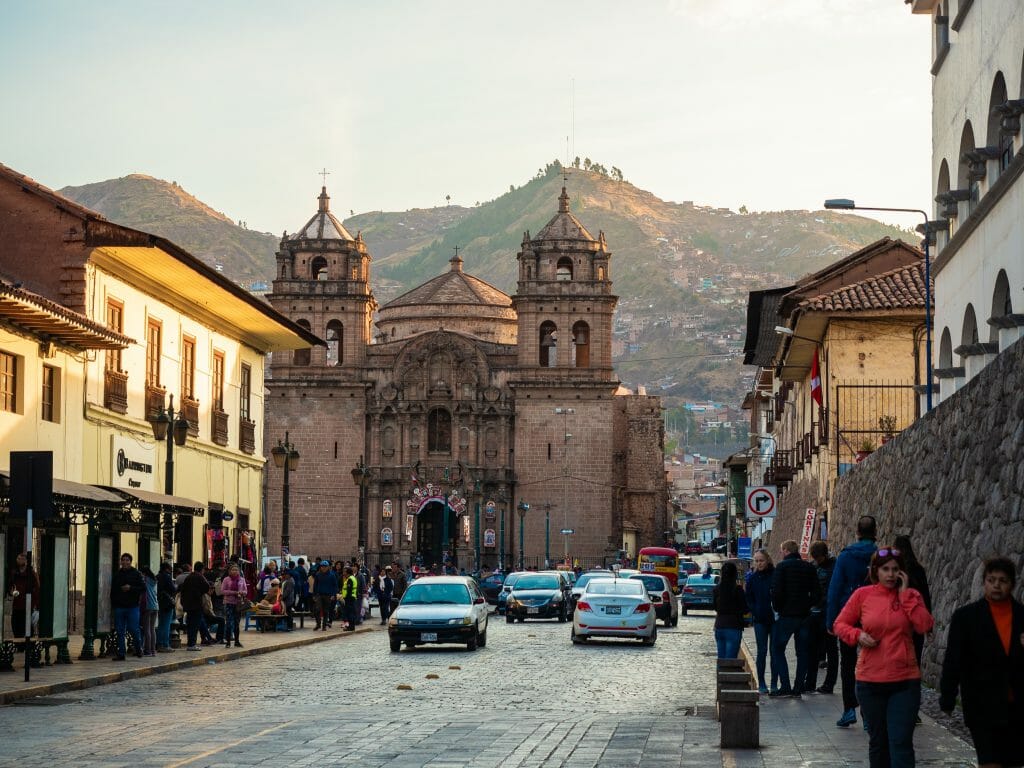
Options for visiting Machu Picchu
There are essentially three ways to visit Machu Picchu, and I’ll describe all of them in immense detail below! Here’s a quick overview:
1. DIY Machu Picchu: organising your own tickets and transport
Why choose this option: journey to Machu Picchu independently and explore at your own pace, all while saving considerable $$ compared to trekking or joining a guided tour from the city
What’s involved: you’ll have to spend a fair bit of time coordinating your transport from Cusco to Machu Picchu, as well as purchase your own tickets online and organise a guide at the entrance to the ruins (new 2019 requirement), but you can choose whatever times, transport, and accommodation options seem most appealing to you
2. Adventurous Machu Picchu: trekking to the Incan ruins
Why choose this option: trek through absolutely breathtaking scenery en route to Machu Picchu, experience the wonder of the Andes, and learn more about the ancient Incas along the way
What’s involved: trekking at altitude is not for the faint of heart and typically involves 3-5 days of moderately difficult ascending and descending; depending on the trek, it can be quite reasonably priced (Salkantay) or very expensive (Inca Trail)
3. Stress-free Machu Picchu: joining an organised tour
Why choose this option: make your way to Machu Picchu from Aguas Calientes, Cusco, or even Lima without any of the planning or stress of travelling alone in a foreign country
What’s involved: if you’re willing to spend the money, you can book an inclusive tour that will handle all of your transport, ticketing, and scheduling for you
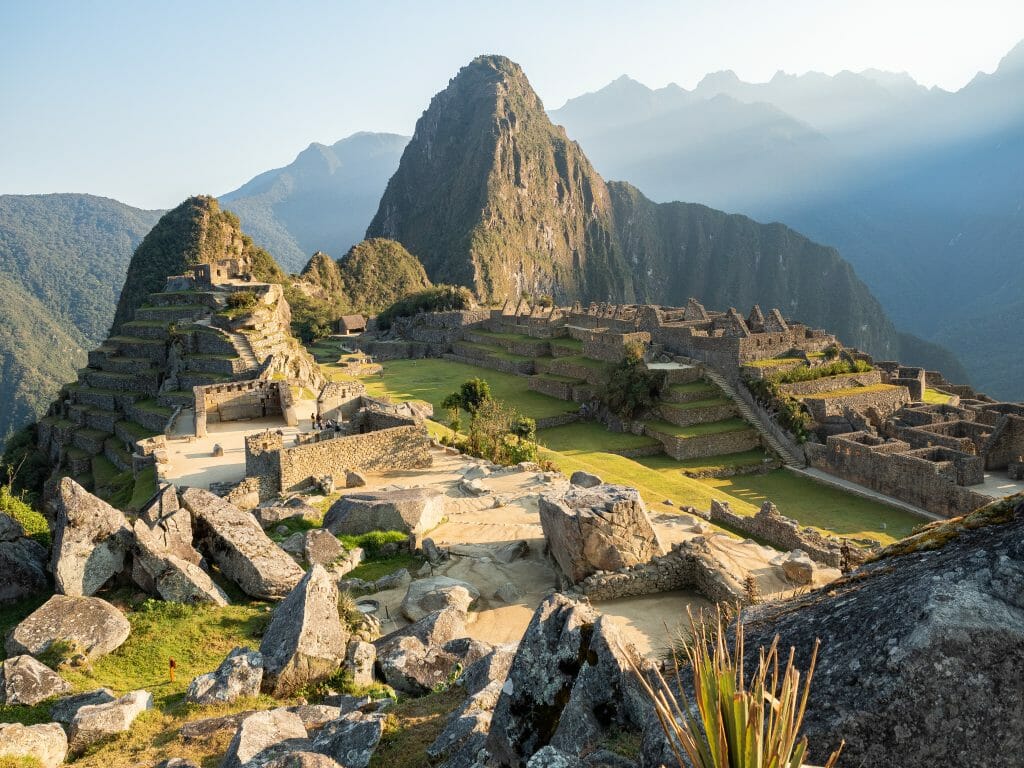
New 2019 Machu Picchu regulations
Since my first visit to Machu Picchu in 2014, a series of significant changes, the most recent of which were enacted in 2019, have been implemented at the site to reduce the impact of heavy tourism and preserve the beauty of this World Wonder.
Ultimately, these changes are an important step towards greater sustainability (I think we can all agree it would be an international tragedy if the site was forced to close as the result of tourist damage), but they also make post-2019 visits to Machu Picchu a bit different than you might be imagining.
I’ll talk about some of these regulations throughout the post, but here are the most important changes and how they are likely to impact your visit:
- You will have a specific time-slot for entry: In an effort to alleviate the intense morning rush at Machu Picchu, there are now a number of time-slots for entry (e.g. 6am ticket = entry between 6-7am, 7am ticket = entry between 7-8am, etc) that you will choose from during the ticket reservation process (more details further down this post). It means you won’t be able to just “get there when you get there”, but it also means that there aren’t 3,000 people all trying to enter at the exact same time, so it should actually make your visit nicer. If you want to snatch up one of the early slots for sunrise, you will need to plan early, because these are popular!
- You will follow a set route: When you enter Machu Picchu, you can now follow one of only a few set routes through the site. This is my least favourite of the new regulations— it’s impossible to backtrack, so if there is considerable cloud-cover obscuring Machu Picchu as you make your way past the iconic photo points (which is very common in the morning), well tough cookies, that was your one and only chance to get the shot. Plan accordingly.
- Time inside the ruins is limited to 4 hours: Once upon a time, you could spend the entire day exploring the ruins and taking photos from every angle, but your visit is now restricted to just 4 hours. Unsurprisingly, this time limit isn’t heavily enforced, but 4 hours is actually plenty for most people to make their way around the site.
- BUT climbers are allowed re-entry: If you are climbing Huayna Picchu or Machu Picchu mountain, you’ll actually be allowed to exit the site and re-enter anytime that same day. This is excellent, because 4 hours is not really enough time to explore the ruins AND climb the mountain! It also makes climbing tickets doubly valuable, since you will be able to visit viewpoints and other scenic parts of Machu Picchu twice, while “ruins only” ticket-holders only have one pass at it based on the new one-way regulations.
- You are required to hire a guide: Essentially providing supervision to all of the tourists at Machu Picchu, you are no longer allowed to wander around the ruins on your own, but instead must pay for a guide. For those on a guided tour or one of the treks (Inca Trail, Salkantay, etc), this is typically included, but for those visiting independently, you’ll be able to hire a guide at the entrance gates when you arrive (more details further down this post). Although this didn’t appear to be strictly enforced, it’s actually great to have a guide anyway— someone who knows all of the history (and how to get around) can really enrich the experience, so I see this as a positive.

Clear skies and sunny weather at Machu Picchu
1 | DIY Machu Picchu: organising your own tickets and transport
For the intrepid traveller looking to completely control their own Machu Picchu experience (and save some money), a DIY trip can be extremely rewarding. Be warned that this option involves the greatest amount of planning and organisation, but it’s entirely doable with the help of this guide, which will walk you through purchasing tickets, options for your visit, and how to get to Machu Picchu independently.
Estimated total cost: $300-400USD (1-2 days)
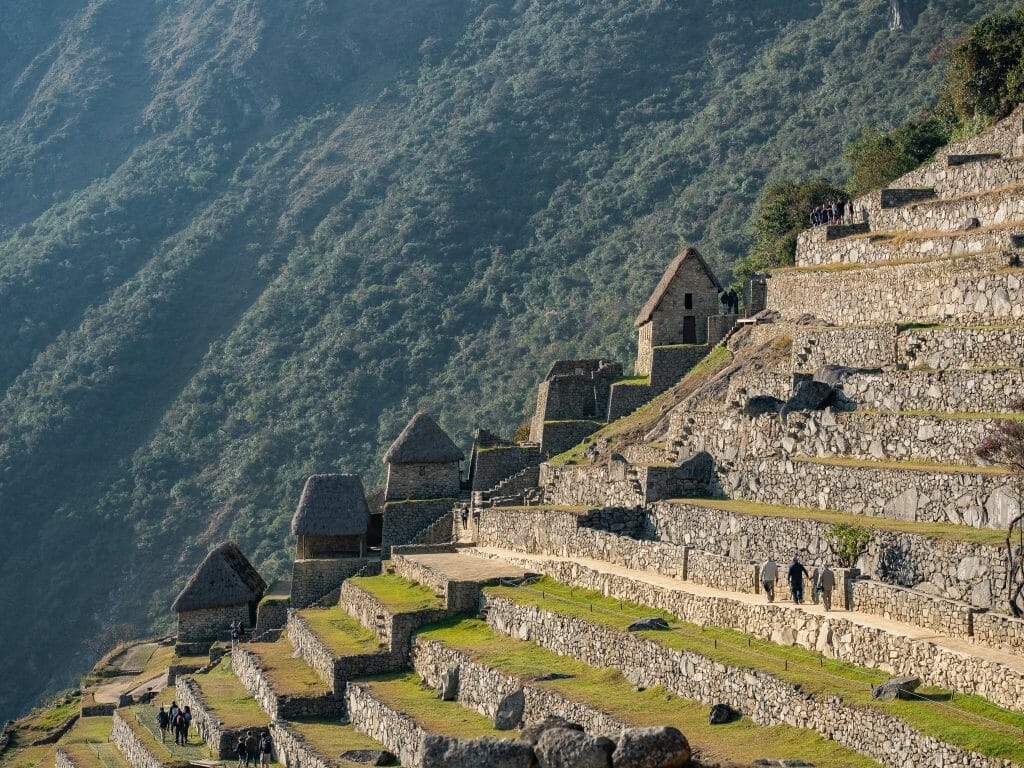
Buying Machu Picchu tickets
When to buy your Machu Picchu tickets
Thousands of tourists visit Machu Picchu every single day— as a general rule, you should purchase tickets for Machu Picchu (ruins only) a month in advance and tickets for Machu Picchu + Huayna Picchu (more on this below) around 3 months early.
This is particularly important during the high season from (June to September), where it’s not uncommon for tickets to completely sell out as the day approaches. Machu Picchu is incredible and everyone wants to visit, so don’t leave this until the last minute if you aren’t flexible with dates!
Where to buy your Machu Picchu tickets
Prior to visiting Machu Picchu, you’ll need to reserve tickets for a specific date and time-slot— and it’s important to note that no tickets are sold directly at the site, so this MUST be done in advance!
It’s possible to purchase tickets when you arrive in Peru from either Cusco or Aguas Calientes (the town just below Machu Picchu), but you’ll be far more likely to get your first choice by reserving tickets online in advance.
You can purchase tickets directly through the official booking site, which will give you the absolute lowest price, or through a third-party site reselling the tickets, which is really only for those with absolutely zero spare time to sort the tickets out themselves (it isn’t difficult, so I recommend saving your money!).
In person (don’t forget your passport!)
- Cusco: Ministerio de Cultura, Casa Garcilaso on Calle Garcilaso (Monday to Saturday, 7am-8pm)
- Aguas Calientes: Machu Picchu Cultural Centre, Avenida Pachacutec (Monday to Sunday 5am-10pm)
Online
- Official Ministerio de Cultura website: purchases can be made with a credit card, just be sure to save the reservation number as you will need it to “check in” and print your tickets from the site
- Third-party sites, such as Get Your Guide or Viator (not recommended)
Machu Picchu ticket options
You need to decide if you want access to the ruins only or if you wish to climb Huayna Picchu or Machu Picchu Mountain as well. New 2019 regulations also mean that you’ll need to select a specific time at which to enter the archaeological site (not simply “morning” or “afternoon”, as before), and then you will have just 4hrs to explore (unless climbing a mountain, in which case you get extra time and re-entry to the site on the same day).
If you have your heart set on viewing the ruins at sunrise (which is amazing when the weather cooperates), you’ll want to reserve a 6am ticket, whereas the 2pm time-slot might offer you a less-crowded afternoon at Machu Picchu. Here are all your options:
Machu Picchu ticket (ruins only)
- Includes: entry into Machu Picchu Archaeological Site only (not including a climb of either Huayna Picchu or Machu Picchu Mountain)
- Times: hourly time-slots to enter Machu Picchu from 6am to 2pm (e.g. 6-7am time-slot, 7-8am time-slot, 8-9am time-slot, etc), each allowing 4hrs of access to the ruins
- Cost: S/152
Machu Picchu + Huayna Picchu ticket
- Includes: entry into Machu Picchu Archaeological Site plus access to climb beautiful Huayna Picchu (2-3hr steep hike; see detailed information below under What to expect at Machu Picchu)
- Times: 6-7am time-slot to enter Machu Picchu (7-8am timeslot to begin the Huayna Picchu climb); 7-8am time-slot to enter Machu Picchu (7-8am timeslot to begin the Huayna Picchu climb); or 8-9am time-slot to enter Machu Picchu (10.30-11.30am timeslot to begin the Huayna Picchu climb), all allowing re-entry to the ruins to explore more after your climb
- Cost: S/200
Machu Picchu + Machu Picchu Mountain ticket
- Includes: entry into Machu Picchu Archaeological Site plus access to climb the easier Machu Picchu Mountain(1.5-2hr hike; see detailed information below under What to expect at Machu Picchu)
- Times: 6-7am time-slot to enter Machu Picchu (7-8am timeslot to begin the Machu Picchu Mountain climb); 7-8am time-slot to enter Machu Picchu (7-8am timeslot to begin the Machu Picchu Mountain climb); or 8-9am time-slot to enter Machu Picchu (9-10am timeslot to begin the Machu Picchu Mountain climb), all allowing re-entry to the ruins to explore more after your climb
- Cost: S/200

Getting to Machu Picchu
Step 1: Cusco to Aguas Calientes
The first stage of travel to Machu Picchu, which is actually a bit more involved than people realise, is to get yourself from Cusco to Aguas Calientes (literally Hot Waters), the tourist-town located at the base of Machu Picchu. The good news is that this train journey is considered one of the best in the world, following the exact route that Hiram Bingham took to the citadel in 1911.
The best way to reach Aguas Calientes is via train, either Peru Rail or Inca Rail, but unfortunately neither of these companies actually depart from central Cusco, necessitating some additional travel steps. Here are the main options for getting to Aguas Calientes:
Catch the train from Poroy Station to Aguas Calientes
- Organise a taxi (S/20) or colectivo (S/6) to take you from Cusco to Poroy (30min)
- Catch the Inca Rail train (about S/300) from Poroy to Aguas Calientes (3hr20m)
Catch the train from Ollantaytambo Station to Aguas Calientes
- Take a taxi (S/80) or the Real Inka shuttle (S/15) from Cusco to Ollantaytambo (2hrs)
- Catch either the Peru Rail or Inca Rail train (about S/250) from Ollantaytambo to Aguas Calientes (1hr50min)
Book the “Bimodal service” with Inca Rail
- Inca Rail offers a direct service of sorts by organising a bus between Cusco and Ollantaytambo, and then a train onwards to Aguas Calientes (at around S/330, this seems like a really attractive option)
Check out times and current prices for Peru Rail or Inca Rail
Note: If you’re hoping to do Machu Picchu as a single day trip from Cusco, it’s possible, but it’s going to be a LONG day— most people opt to spend one night in Aguas Calientes or even in Ollantaytambo, which is a beautiful spot in the Sacred Valley (more so than Aguas, which is very touristy). I’d recommend buying your train tickets for the day before your Machu Picchu tickets.
Step 2: Aguas Calientes to Machu Picchu
From Aguas Calientes, there are two option to reach the actual entrance to Machu Picchu (and sort of a third, fancy-pants option):
Hike to Machu Picchu
It’s an absolutely beautiful hike up to the ruins, just know that you’ll definitely work up a bit of a sweat. If you want to enter Machu Picchu when it first opens at 6am, you need to leave Aguas Calientes around 4.15/4.30am at the latest.
It’s a 15min walk downhill to the first control gate, where you’ll need to queue up for the stairs (the first of many queues today). They will check your tickets and passport here, but you can’t actually start walking until 5am (make sure to bring a headlamp or torch!). It will take 45-60min to climb the 1,800 stone steps up to the entrance and you should be able to enter as one of the first 100 or so people.
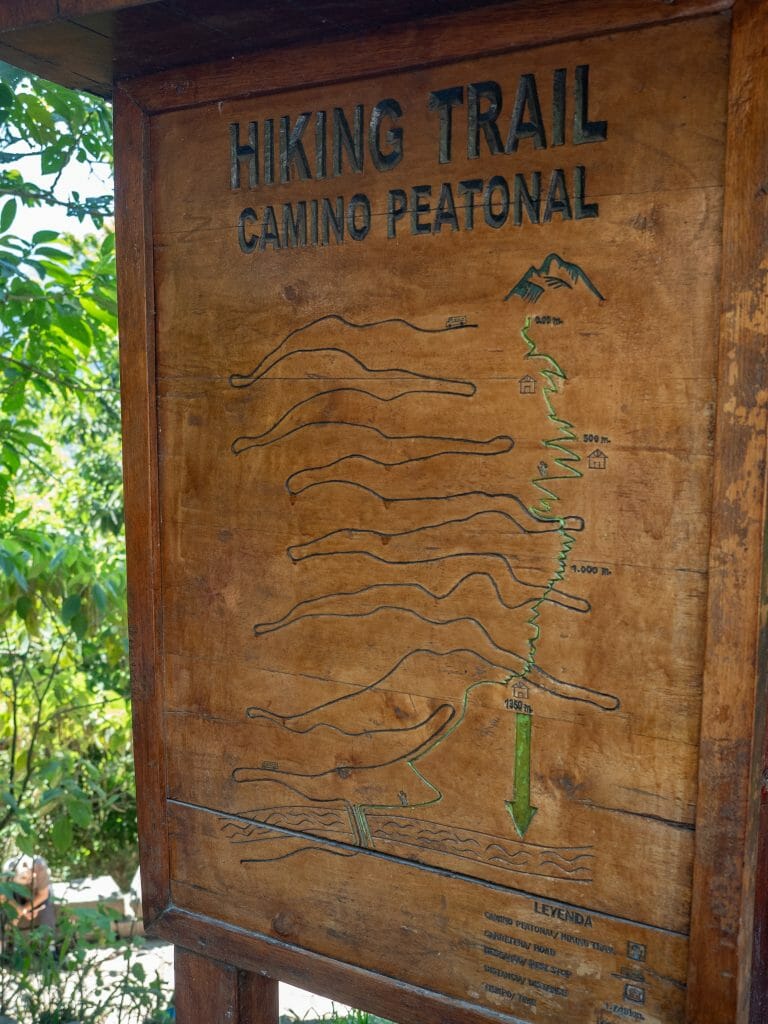
Take the bus to Machu Picchu
If you aren’t terribly keen on walking, are trying to save your energy for exploring Machu Picchu, or you just want to get to the ruins as quickly as possible, the bus might be a better option. Shuttles depart constantly throughout the day (beginning at 5.30am), but the queue is somehow always a million people long, so factor in at least an hour of wait-time in addition to the 30min ride up to Machu Picchu so as not to be late for your ticket entrance time.
If you have a 6am ticket and want to be among the first people inside, you need to catch one of the first 3 buses from Aguas Calientes— join the queue at 4.15/4.30am at the latest. Buses depart from a very obvious stop on Avenida Hermanos Ayar (marked very conveniently on Google Maps as “Bus to Machu Picchu”) and cost $12, payable directly at the bus stop (but it’s better to purchase in advance the night before from the nearby Consettur office).

Stay at the Belmond Sanctuary Lounge
For the most luxurious, budget-busting experience at Machu Picchu, you can actually stay right at the entrance to the ruins in the Belmond Sanctuary Lodge. Even the most basic rooms are upwards of $1,200USD, but I’m sure it would be incredible to catch glimpses of Huayna Picchu and Machu Picchu from your bed!
If you want to splurge on this, just know that you will need to purchase tickets for the private Consettur bus when you arrive at Aguas Calientes station.

Laguna Humantay on the Salkantay Trek to Machu Picchu
2 | Adventurous Machu Picchu: trekking to the Incan ruins
For an active approach to Machu Picchu, some truly incredible Andean scenery, and immersion into ancient Incan culture, consider one of several treks in the region that either conclude at Machu Picchu or Aguas Calientes (the town just below Machu Picchu).
I’ve personally hiked the Inca Trail and Salkantay Trek, both of which are incredible, but the Lares Trek is also an emerging option for those hoping to escape the “beaten path”. Check out all of my recommendations about these 3 treks below, including a comprehensive packing list and some tips on trekking at altitude.
Estimated total cost: $400-800USD (3-5 days)

Choosing a trek
Inca Trail
“Re-discovered” by archaeologist Hiram Bingham on his famous 1911 expedition, the Inca Trail was once a pilgrimage route to Machu Picchu, along which walkers performed religious ceremonies and spiritual rituals to honour the towering Apus (mountain gods).
Today, it’s the most popular trekking route to Machu Picchu, winding for 4 days through lush jungle and impressive Incan ruins to culminate at Machu Picchu’s magnificent Sun Gate. The hike itself is fairly steep, but not overly challenging— coupled with the altitude, however, it can feel somewhat difficult if you’re not properly acclimatised. The highest point on the trail, Warmiwañusqa (very aptly referred to as Dead Woman’s Pass), sits at 4,215m and it’s a fair battle to get up and down from here!
The government only allows 200 hikers to depart on the Inca Trail each day, all of whom must be accompanied by a tour guide, and these passes consistently sell out months in advance. As a result of the high demand, Inca Trail tours run anywhere from $500 to $1000USD, but typically provide a very high standard of food and accommodation (all camping equipment supplied and assembled for you each afternoon) and porters who will carry the bulk of your gear and clothes. For the history alone, this trek is an amazing experience and I absolutely loved every moment (even if it was the middle of the wet season).
Time needed: 4 days
Distance: 43km
Difficulty: moderate
Recommended company: Wayki Trek, $780USD (the company I went with in 2014)
Read more about the Inca Trail: HIKING TO MACHU PICCHU: COMPARING THE CLASSIC INCA TRAIL VS SALKANTAY TREK
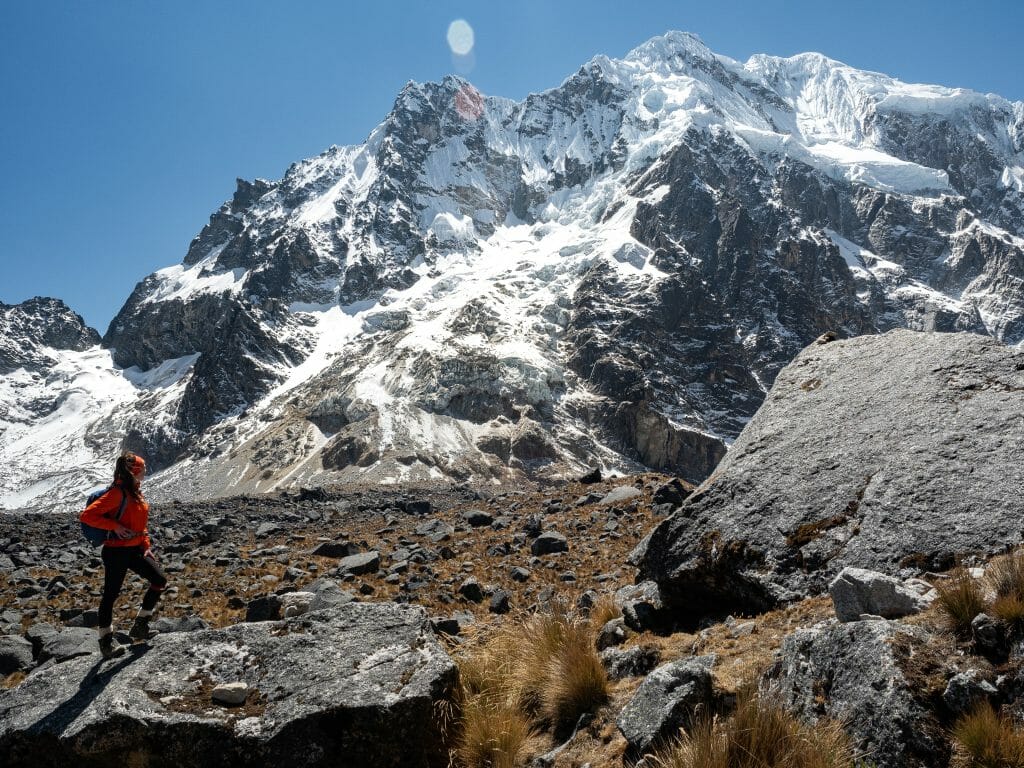
Salkantay Trek
An increasingly popular but still far less crowded alternative to the Inca Trail, the Salkantay Trek traverses high mountain passes and stunning alpine scenery to reach the incredible ruins of Machu Picchu (via Aguas Calientes). The trek takes its name from Salkantay Mountain, which rises an impressive 6,271m and absolutely dominates the landscape during the first half of the trip, but the Quechua translation “Savage Mountain” at times feels more fitting (particularly as you puff towards the route’s high point, 4,650m Salkantay Pass).
The complete Salkantay Trek from Mollepata to Aguas Calientes is around 70km and can be completed in 5 days. However, a number of modifications can be made to this trek thanks to nearby roads/trains, which effectively cuts out the penultimate day for a shortened 4-day trek or a challenging 3-day trek. The final night of the Salkantay Trek is spent in a hotel in Aguas Calientes, and then you will rise early to make the final journey up to Machu Picchu on foot (45min up 1,800 steps) or via shuttle bus (the same bus I described in the previous section; buy tickets in Aguas Calientes the night before). In terms of scenery (and the ability to shower before visiting Machu Picchu), I actually enjoyed this trek more than the classic Inca Trail, although both are still fantastic options!
If you’re still struggling to choose a trek, I wrote a whole post comparing the Inca Trail and Salkantay Trek based on difficulty, scenery, price, etc: HIKING TO MACHU PICCHU: COMPARING THE CLASSIC INCA TRAIL VS SALKANTAY TREK
Time needed: 3-5 days
Distance: 60-70km
Difficulty: moderate
Recommended company: Salkantay Trekking, $400USD (the company I went with in 2019)
Read more about the Salkantay Trek: SAVAGE MOUNTAIN TO MACHU PICCHU: A COMPLETE GUIDE TO HIKING THE SALKANTAY TREK IN PERU
Lares Trek
Although I haven’t actually completed this trek myself, I’ve heard from several people that the Lares Trek is a great alternative route to Machu Picchu, and one that promises a more off-the-beaten-path experience. It lacks the Incan ruins you’ll see along the Inca Trail and the dramatic alpine scenery of the Salkantay Trek, but the Lares Trek boasts its own share of beautiful scenery, as well as the opportunity to interact more closely with some fascinating and welcoming Andean communities.
Time needed: 4 days
Distance: 42km
Difficulty: easy/moderate
Recommended company: Flashpacker Connect, $775USD (I enjoyed my Ausangate trek with Flashpacker)
Trekking inclusions
Although inclusions differ slightly between companies and trekking routes, there are still some commonalties, specifically that the trekking company will organise your transport to and from the trek/Machu Picchu, purchase Machu Picchu tickets for the group, and provide a guide at the site. The treks also include food and accommodation (either in tents that they will erect for you or in huts) and porters or horses that will carry a bag of your belongings (typically 6-7kg in a duffel) so that you only need to haul a small backpack with some essentials.
Read this post for more about trekking inclusions: SAVAGE MOUNTAIN TO MACHU PICCHU: A COMPLETE GUIDE TO HIKING THE SALKANTAY TREK IN PERU
As a result of all these inclusions, I found trekking to Machu Picchu (on the Inca Trail, but especially on the Salkantay Trek) to be extremely luxurious and suited to anyone of moderate fitness. The most important thing to consider is just acclimatisation— as these treks are all at a reasonably high elevation, it’s crucial to spend several days in Cusco prior to departure to ensure that your body is at least somewhat adjusted to the altitude.
Read this post for more information about trekking at altitude and lots of helpful tips to prevent altitude sickness: HIGH-ALTITUDE TREKKING: A COMPLETE GUIDE TO PREVENTING & TREATING ALTITUDE SICKNESS IN THE MOUNTAINS

Packing for a hike to Machu Picchu
This is a general year-round packing list for the Inca Trail, Salkantay Trek, or Lares Trek that should cover all of the essentials for trekking to Machu Picchu. Keep in mind that the weather can be chilly and unpredictable in the Andes regardless of the time of year, so don’t skimp on the layers or you might sorely regret it.
I’ve linked to all the gear I used below, but if you’re looking for more specific recommendations on trekking gear, check out this post: BUILDING THE ULTIMATE OUTDOOR ADVENTURE KIT: THE BEST HIKING & BACKPACKING GEAR FOR WOMEN
To wear on the first day
- Sport shirt
- Light fleece jumper
- Wind jacket
- Down jacket, you’ll want this on the drive, but it can go into your daypack after you start trekking and be worn around camp in the evenings/early mornings
- Tights or hiking pants
- Sturdy hiking boots, with thick wool socks and hiking liners
- Trekking poles, possible to purchase in Cusco or hire from your trekking company for about $20USD if you don’t own any poles; 100% essential in my opinion
To keep in your daypack (~25L)
- Water bladder or bottle, enough to carry 1-2L of water
- Small snacks, like nuts or protein bars (although you will also receive snacks from the trekking company)
- Rain jacket
- Sunnies
- Sunscreen
- Bug spray
- Warm gloves, two pairs for Salkantay if you get really cold
- Warm hat
- Camera, plus spare batteries
- Drybag, to protect your electronics/other valuables in heavy rain
- Rain cover for your daypack, or you can purchase a plastic poncho that will cover you and your pack for a few Soles along the trail (if you’re hiking in the rainy season, bring BOTH)
To pack in the duffel (6-7kg, carried by porters or horses)
- 2x spare hiking shirts, short sleeve or singlets
- Mountain jacket, great for hiking in chilly weather (since you really don’t want to sweat in your down jacket)
- Spare hiking shorts or tights
- 2x spare hiking socks and liner pairs
- Spare underwear
- Fleece tights or pants, for sleeping (I wore mine over the top of hiking tights on the coldest nights)
- Camp shoes, such as sandals or runners to wear around camp after each day’s hike
- Machu Picchu clothes, which might not be anything other than what you already packed, but maybe you want a sundress or even just clean clothes for your pictures at the ruins (as you can tell from my photos, I did not pack this, but it would have been nice!)
- Toothpaste/toothbrush
- Soap/shampoo, you have the opportunity to shower the night before you visit Machu Picchu in Aguas Calientes (not on the Inca Trail!)
- Body wipes, for a “mountain shower”
- Acetazolamide/Agua Florida/coca candies, for altitude sickness
- Sleeping bag, rated to -15C or similar; most companies will hire these out for about $20USD if you don’t have one with you
- Camping pillow, if you are one of those people who needs 2 pillows when you sleep (like me)
- Headlamp, helpful for finding your way around camp in the evening
- Powerbank, for charging your camera/phone
- Passport, essential to enter Machu Picchu
- Soles, for tipping and optional extras like the bus to Machu Picchu (not for the Inca Trail) and lunch in Aguas Calientes on day 4. I’d recommend S/300 just to be super safe, but there are also heaps of ATMs in Augas Calientes and most restaurants accept card.
- Credit card

Machu Picchu bathed in golden early morning light
3 | Stress-free Machu Picchu: joining an organised tour
There are a seemingly endless number of companies operating day or multi-day tours to the Incan ruins from Aguas Calientes, Cusco, or even from Lima. This can be a great option for those who don’t want to spend hours organising their own tickets and transport, or even for those who don’t feel comfortable travelling alone— I recently helped my mum book a group tour to Machu Picchu (something that’s been on her bucketlist for 30 years) and she had a wonderful time!
Depending on the company, you’ll need to book your Machu Picchu tour about 6 months in advance to guarantee the dates you want; it’s a good idea to reserve a tour before you even buy plane tickets.
Inclusions and quality can vary widely between companies, but I’ve personally had wonderful experiences with Wayki Trek and Salkantay Trekking on other treks and my mum highly recommends G Adventures/National Geographic based on her September 2019 Machu Picchu and Sacred Valley tour.
Estimated total cost: $300-2,000USD (1-8 days)
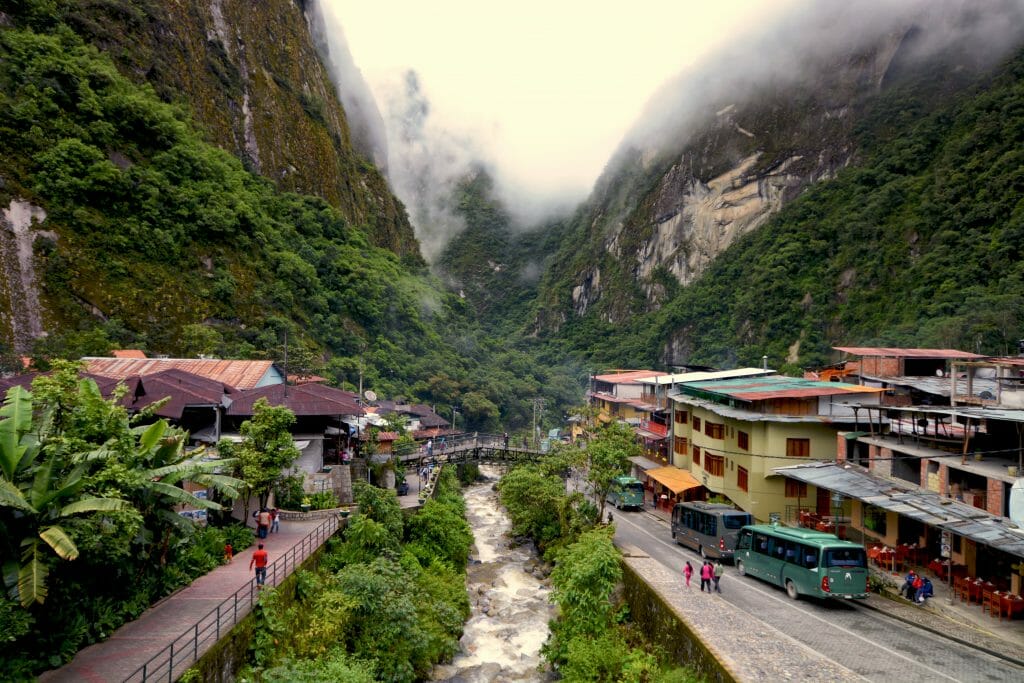
Popular tour options
Tours from Aguas Calientes
If you are comfortable organising your own train transport to Aguas Calientes (the town just below Machu Picchu; see earlier DIY section for all the details on travelling from Cusco to Aguas Calientes), then the cheapest option will be to book a tour from Aguas Calientes. These can usually be reserved last minute!
Look for tours that include: return bus transport to the ruins, entrance ticket, a designated guide within Machu Picchu
Expect to pay: $150-200USD
Additional costs: $200 for transport to and from Aguas Calientes, $20-50 hotel in Aguas Calientes
Try this: Machu Picchu Afternoon Entrance Ticket, Bus & Private Guide
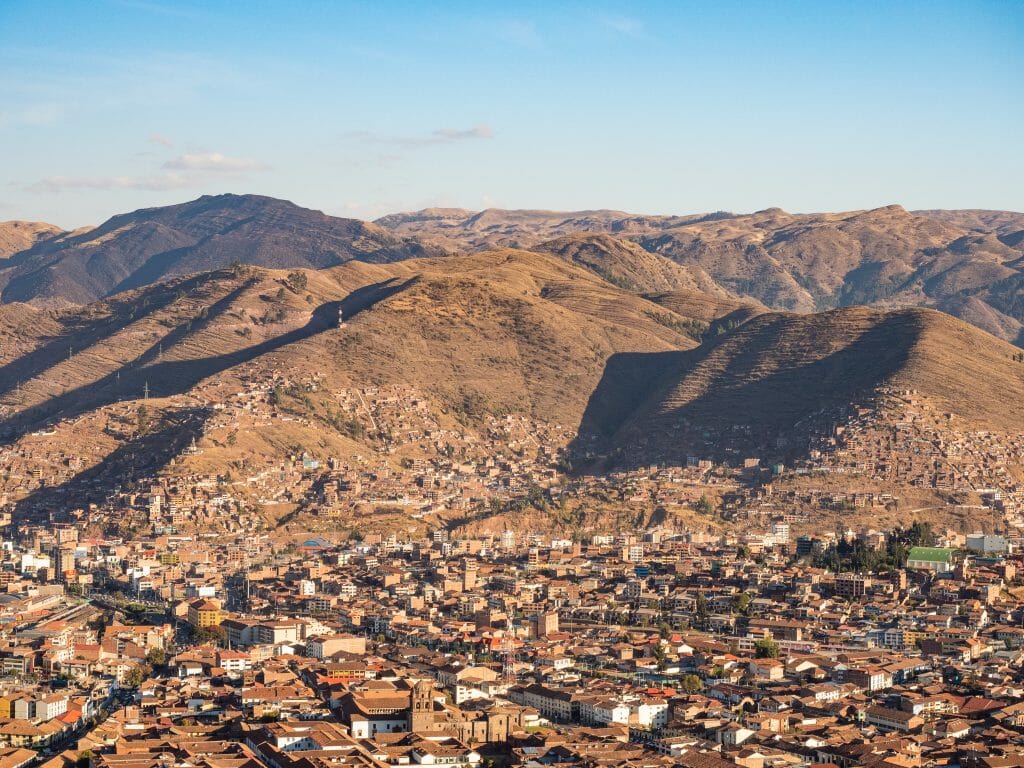
Tours from Cusco
More commonly, tours will depart from Cusco for a more all-inclusive experience that involves absolutely zero planning on your part. This option is particularly great for those who only have one day— tours will pick you up from your hotel in Cusco around 3am and return around 9pm.
Look for tours that include: transport from your hotel in Cusco to the train, return train tickets to Aguas Calientes, return bus transport to the ruins, entrance ticket, a designated guide within Machu Picchu
Expect to pay: $300-500USD
Try this: Machu Picchu Full Day Tour with Salkantay Trekking (that’s just the name of the company, no actual trekking involved!)

Tours from Lima
For the most hassle-free option, look for tours depart Peru’s capital, Lima. This is what I’d recommend for someone who doesn’t want to travel alone at all, since you’ll even fly to Cusco with the tour group. These tours usually also include guided experiences in Lima, Cusco, and the Sacred Valley over about 6-8 days.
Look for tours that include: return flights from Lima, hotel in Cusco, transport from your hotel to the train, return train tickets to Aguas Calientes, return bus transport to the ruins, entrance ticket, a designated guide within Machu Picchu
Expect to pay: $700-2000USD
Try this: 8-day Explore Machu Picchu tour with National Geographic Journeys/G Adventures (the tour mum took recently)

Machu Picchu as seen from Huayna Picchu
*What to expect at Machu Picchu
Crowds
The unfortunate reality of visiting a popular destination like Machu Picchu is that you are going to be sharing your magical experience with thousands of other people.
And Machu Picchu can get crazy busy, so if you want photos without hordes of tourists in the background or if you want to actually explore some of the temples and other significant buildings around the site without feeling like a salmon swimming upstream,
I’d strongly recommend coming first thing in the morning or late in the afternoon. If you can be one of the first people in the gates at 6am, it’s totally possible to get photos of Machu Picchu that look nearly empty!

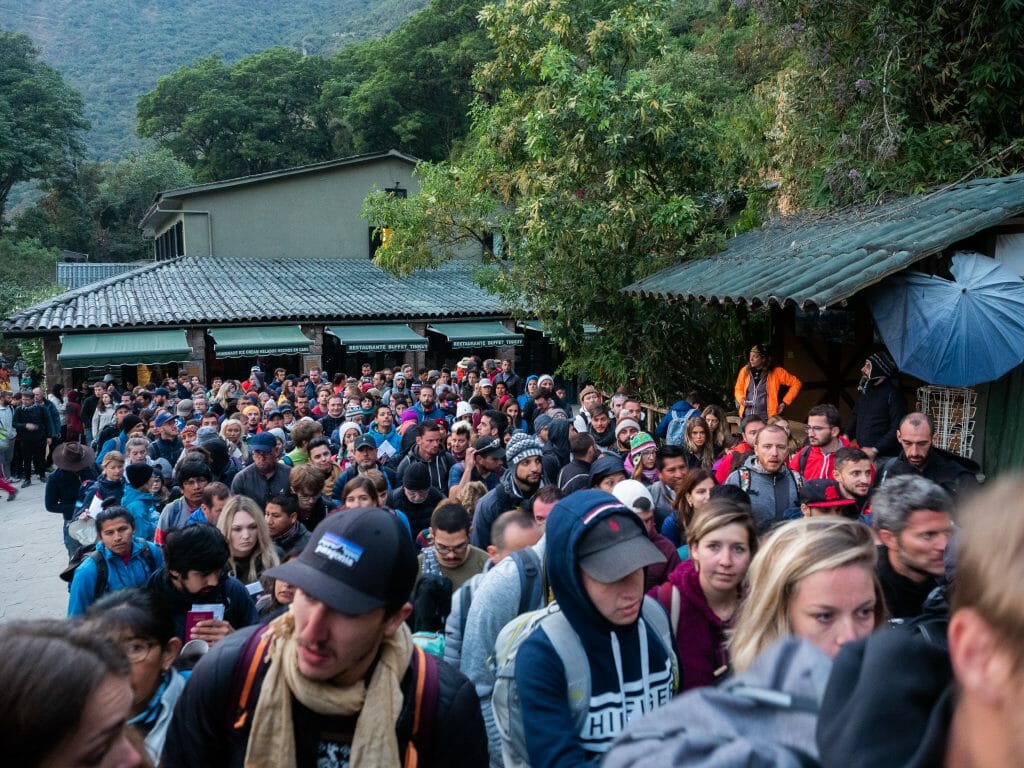
Guided tour of the ruins
As I mentioned previously, you are now required to have a guide at Machu Picchu, and even though it’s not strictly enforced, I’d definitely recommend it! You will get a lot more out of the site with a knowledgable guide.
If you are visiting on your own (since treks and tours will already have organised this for you), it is super easy to hire a guide at the main entrance when you arrive. The standard for guides in Peru is also insanely high, so you should be able to find one who has a degree in tourism and speaks good English; the going rate is about S/100-150 for a 2-3hr tour of the ruins.
Facilities
It might shock some people to know that there are no toilets available for use within Machu Picchu, but there are toilets at the entrance that you can use immediately before and after your tour for S/2. I recommend taking advantage of the opportunity— there’s no option to pop back out for a quick bathroom break mid-visit (unless you have a climbing ticket). Once you’re out, you’re out!
Food & water
There is no food or water available within the ruins, so you should definitely pack a water bottle and some snacks (even though you aren’t technically allowed to bring food in, they don’t check your bag, so go for it). The best place to enjoy a snack is on the summit of Huayna Picchu, far away from all the people below. Just take your rubbish with you and be respectful with where you choose to eat!!
Once you finish your day at Machu Picchu, go for a big lunch in Aguas Calientes— there are heaps of awesome (if expensive) restaurants around!

Climbing Huayna Picchu or Machu Picchu Mountain
In addition to exploring the breathtaking viewpoints and intriguing ruins within Machu Picchu, there are also two mountains above the archaeological site popular with hikers, both of which offer aerial views of the Incan city. I climbed Huayna Picchu in 2019 and it was honestly such a highlight— I’d highly recommend it to anyone looking for a bit of extra adventure during their visit and a unique vantage point of the ruins and surrounding jungle.
If you think you might be interested in climbing either Huayna Picchu or Machu Picchu Mountain, time is of the essence— only 400 tickets are available for each mountain on any given day, and tickets for Huayna Picchu can sell out 6 months in advance during high season while even the less-crowded Machu Picchu Mountain requires months of advance planning.
Even if you are going with an organised tour or joining an Inca Trail or Salkantay trek, passes for the mountains must be reserved with your entrance tickets for Machu Picchu, so you’ll need to let the company know that you’d like to add this optional extra to your trip (usually $20-25USD if booked through a tour company or S/48 if buying your own tickets directly).
Huayna Picchu
Huayna Picchu, meaning “young peak” in Quechua, is the prominent green mountain rising directly behind the Machu Picchu ruins, visible in every photo you’ve seen of the site. The climb ascends about 290m up a seemingly endless series of steps to eventually reach the summit (about 45min to the top), from which there are dramatic views of the ruins below.
The climb up Huayna Picchu may be short, but it is fairly demanding, so I would really recommend having a moderate fitness level for this one!
Read more about climbing Huayna Picchu: SALKANTAY TREK (DAY 4): AGUAS CALIENTES TO MACHU PICCHU & HUAYNA PICCHU
Machu Picchu Mountain
Machu Picchu Mountain sits on the opposite side of the ruins and arguably offers more expansive views of Machu Picchu with Huayna Picchu in the background. This climb is 620m and around 3hrs from start to finish, but apparently it’s less steep and slightly less hair-raising in terms of sheer cliffs and startling drop-offs.
Machu Picchu Mountain doesn’t have ruins along the way, though, so Huayna Picchu remains the most popular option. The benefit of that is being able to book Machu Picchu mountain tickets somewhat last-minute, while Huayna Picchu will surely be sold out months in advance!
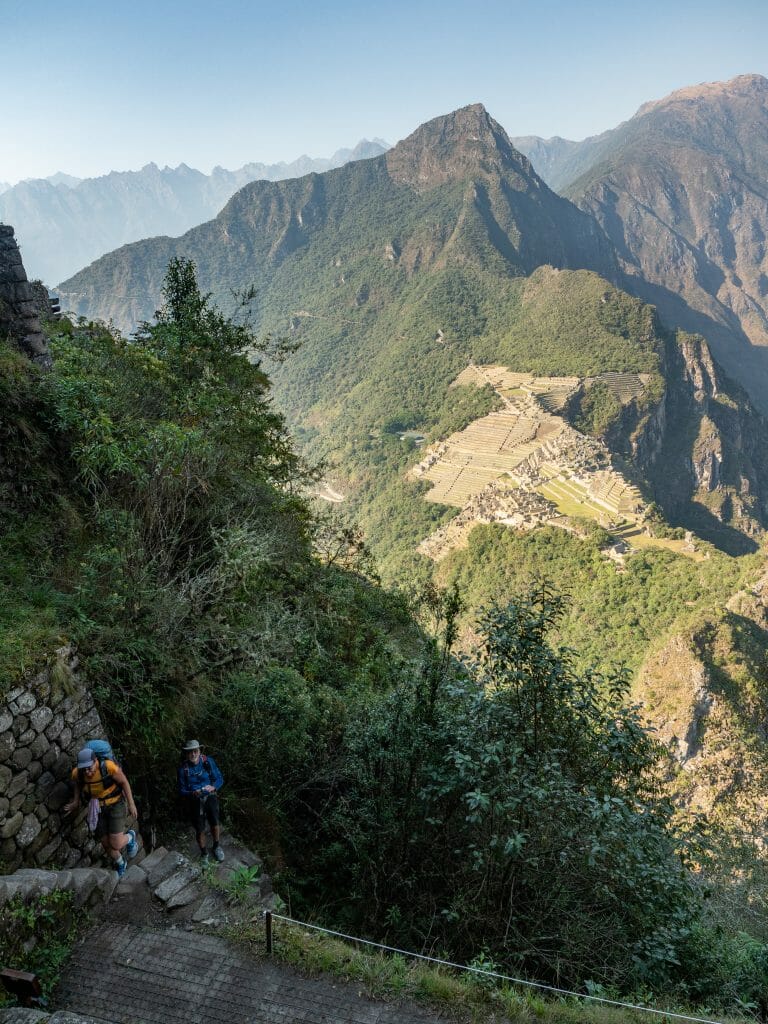
Machu Picchu packing list
What to bring
- Small daypack: the guards are fairly strict about the size of backpack allowed in— anything larger than a daypack should be left at the hotel or kept in a locker at the entrance
- Passport: it’s absolutely vital that you remember your passport if you want to enter Machu Picchu, a photocopy will not suffice in this situation!
- Machu Picchu entry ticket: you’ll need to print a copy of your ticket to present at the ruins
- Camera: do not miss the opportunity to photograph one of the most magical places in the world (leave the tripod at home, though)
- Reusable water bottle: just remember to pace yourself, because you’ll have to exit the ruins to use the toilets!
- Snacks: you’re not technically allowed to bring food into Machu Picchu, but they don’t check your bag, so you can get away with it. Just be responsible and TAKE YOUR RUBBISH WITH YOU.
- Rain jacket: the weather can turn at any moment, so it’s best to be prepared (particularly during the wet summer months, October- April)
- Sturdy walking shoes: these don’t have to be hiking boots (although they certainly can be), but at least wear comfortable runners— there’s a lot of walking involved at Machu Picchu and I definitely wouldn’t want to be doing it in thongs or wedged heels
What NOT to bring
- Large backpack or bulky items
- Camera tripods or selfie sticks: I did bring my GoPro on a pole both times I visited Machu Picchu with no issue, but tripods are a bit more difficult to get away with
- Drones
- Trekking poles/ walking sticks: poles are only permitted for the “elderly or disabled”, so if you look reasonably fit it’s best to leave them in the hotel (if you’re coming straight from the Inca Trail, you can leave them in one of the lockers at the entrance or stow them inside your bag)
And now all that’s left to do is enjoy magical Machu Picchu!
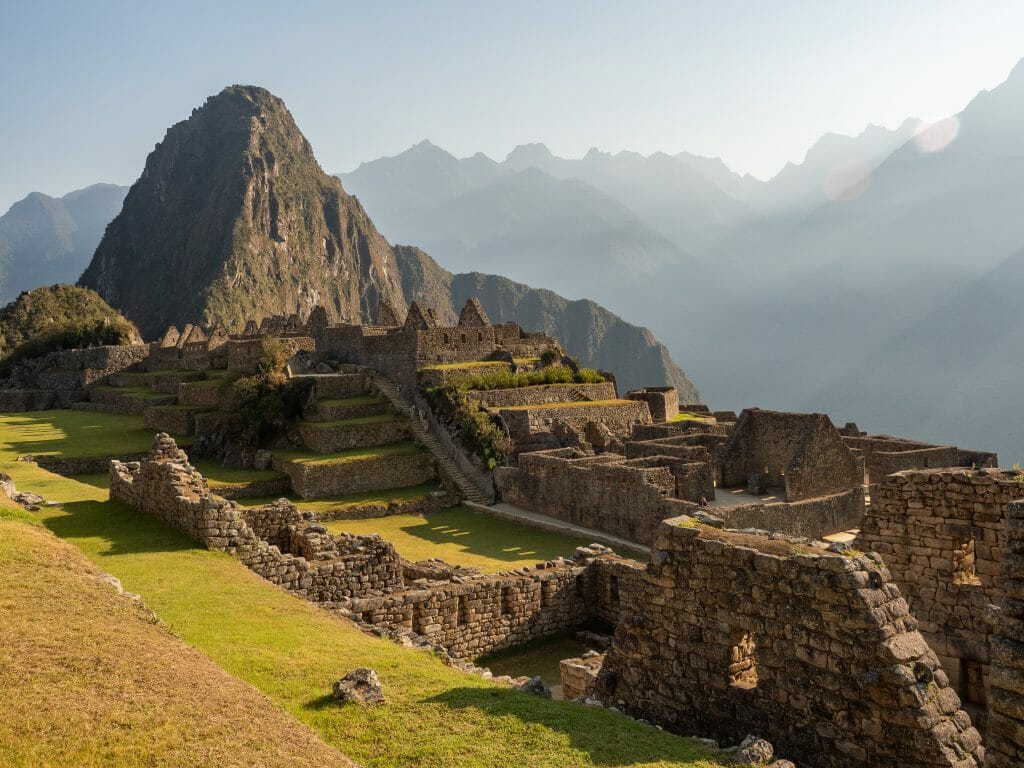
Read more about Peru
THE ULTIMATE CUSCO TRAVEL GUIDE: 25 AMAZING THINGS TO DO IN CUSCO, PERU
HIKING TO MACHU PICCHU: COMPARING THE CLASSIC INCA TRAIL VS SALKANTAY TREK
SAVAGE MOUNTAIN TO MACHU PICCHU: A COMPLETE GUIDE TO HIKING THE SALKANTAY TREK IN PERU
VIA FERRATA CLIMBING & ZIPLINING IN THE SACRED VALLEY: AN ADRENALINE-FILLED DAY TRIP FROM CUSCO
DIY INCA RUINS WALKING TOUR: VISITING TAMBOMACHAY, PUKA PUKARA, Q’ENQO & SACSAHUAMÁN WITHOUT A GUIDE
WHAT TO DO IN LIMA: 10 AWESOME ACTIVITIES IN THE PERUVIAN CAPITAL
THE ULTIMATE GUIDE TO INDEPENDENT & SOLO HIKING THE HUAYHUASH CIRCUIT IN PERU
PACIFIC COAST PERU: 2-3 WEEK PERU TRAVEL ITINERARY FROM LIMA TO CUSCO
INCAS & THE AMAZON: 2-3 WEEK PERU TRAVEL ITINERARY FROM LIMA TO MANU NATIONAL PARK
BEST OF THE PERUVIAN ANDES: 3-4 WEEK PERU TREKKING ITINERARY

The Comments
Luis Amelinckx
Thanks a lot!
That’s really cool information.
brooke brisbine
Luis AmelinckxThanks for reading, Luis, I’m so glad to hear you found this post helpful 🙂
Happy travels!
xx bb